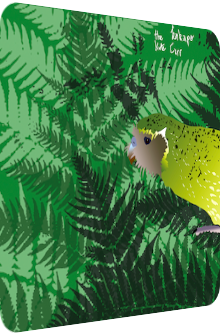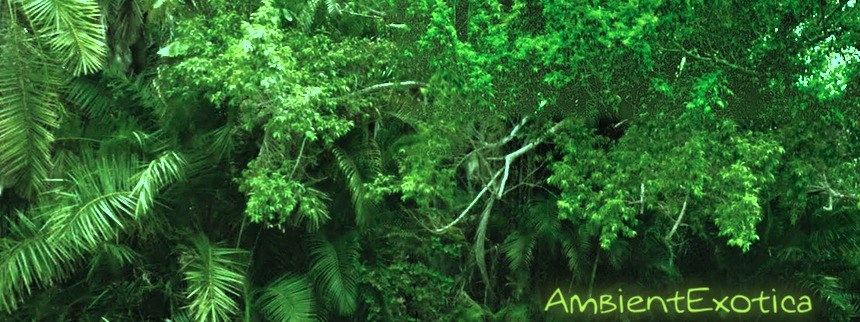
Kate Carr
The Kakapo
2014
It pains me to mention the ineluctable truth, but Kate Carr’s The Kakapo is the endpoint of the wonderful Birds Of A Feather series which inherited a docile and erudite passion of presenting common and exotic birds to the listener, all of them embedded separately in an Ambient track of roughly 20 minutes and envisioned by various electro-acoustic artists, each an expert in his or her field. Released on her Flaming Pines label and available on the label site, the currently London-based Sydneyite has chosen to neglect any form of sentimental feelings or teary-eyed nostalgia and rather favors to go all-in on laying out the, as the press blurb states, “phenomenal” boom of the kakapo, an endemic animal of New Zealand’s mountains which is more than pleased to bask in dirt bowls only to then unfurl its medulla-emptying call which, in the interim, has just become a pinch dirtier than it was heretofore. But there is much more to Kate Carr’s piece than just the bird itself, for The Kakapo, while not even crossing the mark of ten minutes, is a fascinating pintsize piece which delinates a delightfully retrogressive proclivity for Glitch vesicles, bubbles and other artificial elements. Juxtaposed to these strata are a piano and stringed instruments, but these only appear irregularly and in a much more ambient than electro-acoustic way. An enigmatic night is depicted… the last night to be had within the realm of the Birds Of A Feather series.
The Kakapo may be the shortest and most asthenic of all the plummeted critters that are presented in the Birds Of A Feather series, but this species is more than able to leave a lasting impression thanks to Kate Carr’s interesting approach of the curtain call. It turns out that the bird is represented via a strongly recondite atmosphere that sports more than enough Glitch-accentuated illuminants to allow a pristine photometry of scintillating aureoles all across the runtime. Indeed, right from the get-go, one hears the cracking branches and an intertwinement of wonderfully hair-raising remnants of high-voltage influxes and lanthanide blotches. Or is it just a disaccord, an aqueous bonfire? Whatever it is, one thing is for sure: the amalgamation of vitreous blebs, softly scything prongs and clicking clangs results in a wealthy minimalism, a high-plasticity aurora of agglutinating cannelures and interstices of rufescent darkness. One is not exactly welcome in this place, but neither is the listening subject ostracized. It is a rough yet fragile diorama that is aurally painted here.
This train of thought whether one enters a soundscape of benignancy or not doesn’t help much either, especially when the physiognomy of The Kakapo is fluffed a notch or two after the prelude phase. Clocking in at approximately 90 seconds, dark string-like undercurrents and reminiscences of heating circulating pumps veil the darkness with a curious mixture of stokehold romance and a megacity’s pericarp. The piece remains in an uneasily oneiric state though, now featuring thickly wadded bass streamlets, overdriven low frequency protrusions and an aggrandized amount(ain) of the blip-infested granuloma. Accidental melodies, hidden pianos, rubicund strings whirl through the air, and while the chromaticity slowly increases due to the layer entanglement, the epiphany – or theophany? – suddenly hits in the gestalt of a little guy whose theremin-esque rutting call resounds through the night: the eponymous bird arrives at the scene right during the track’s apex.
An owlish chirp, somewhat velvet yet piercing enough to take a stand, the feathery friend or foe makes this an undercover operation regardless, for he chirps only irregularly and lets the surprisingly cinematic sustain of the dark piano key flicker through the nocturnal mountains of New Zealand. Slapped strings, didgeridoo appendixes and wind chime-evoking twinkles show the innermost compunction of creating a moonlit scenery without genuflecting before an all too histrionic take on the Dark Ambient formula. The simultaneity of the countermovements is what makes this piece so clandestinely arcane, or to be more precise: Kate Carr’s pops and clicks are few and far between, but once their impetus increases, they become a moiré, a reticulation that blurs or even swallows the clarity. In these moments, The Kakapo resembles a human’s poor night vision and cleverly augments the fibrillar omnipresence of the darkness that is probably the real force. The artist may not agree with the notion of this being a Dark Ambient sparkler, but there is a reason for this impression, one which must not be spoiled but which is unveiled at the very end of the track, an unexpectedly megalomaniac burst whose absurd nihilism is both a bloodcurdling summation and an intrinsic wakeup call. Oh how I wish it to be only the latter.
If this is the endpoint, the apotheosis and final installment of the Birds Of A Feather series, then all the colors have been successfully annihilated, and this wouldn’t be an overly surprising coup de main, given that many of the previously featured birds are not necessarily colorful at all… Marcus Fischer’s The Crow (2013) comes to mind. Kate Carr’s The Kakapo, while quite a bit more flamboyant in its physical appearance, is a devilish creature otherwise, at least in its sound-based state of less than ten minutes. The remote surroundings are bleak, even dismal, and it is not so much the bird that keeps cawing and flying around the intrinsic boundaries rather than the grim desolation of the landscape whose Lovecraftian grimness radiates and glows as far as to the argentine peripheries of the frequency spectrum. However, as gray and moody the scenery may be, the fleeting visits to Glitch and Dark Ambient make this last entry a delightful one with two fitting foils close at hand: on the one hand, there is Gail Priest’s The Common Koel (2013) and her syringa-colored night at a cesspool which presents a similarly eerie aura that is ameliorated by one remarkable bird; on the other hand, there is the penultimate entry of Philippe Petit called The Kookaburra (2014) with its scraping talons, abrasive burns and static salvos. You will remember the calls of these birds, and the same applies to Kate Carr’s kakapo. Even though the sounds are more raucous, ragged and edgy, with no paradisiac notion, let alone an exotic tone sequence, one can be safe to say: The Kakapo crackles its way to the heart of the listener.
Further listening and reading:
- The Kakapo can be ordered at the Flaming Pines website.
- Follow the label on Twitter: @FlamingPines.
Ambient Review 356: Kate Carr – The Kakapo (2014). Originally published on Jul. 2, 2014 at AmbientExotica.com.
